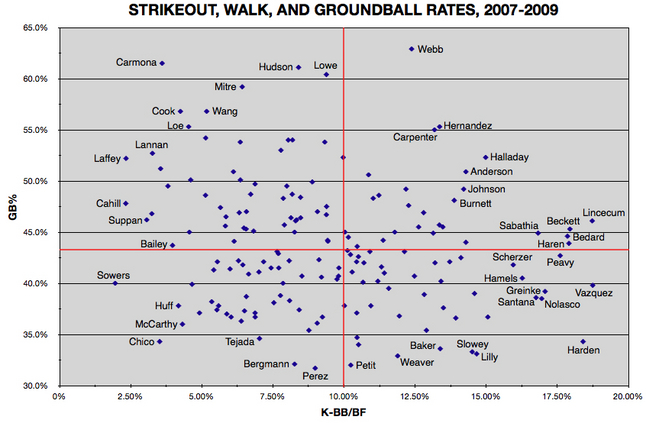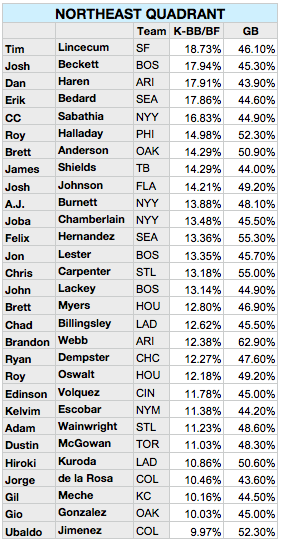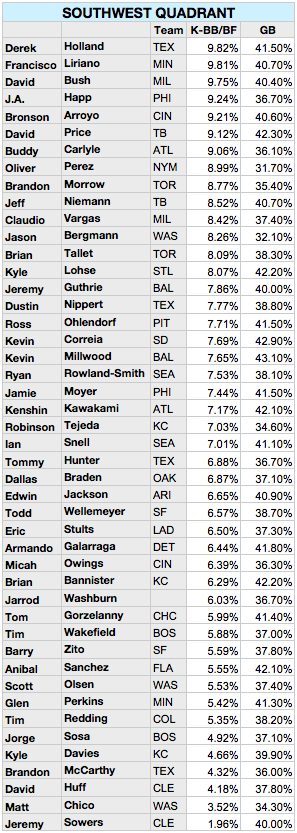
| Baseball Beat | March 22, 2010 |
More than a decade ago, Defense Independent Pitching Stats (DIPS) introduced the idea that pitchers are mostly responsible for their strikeout, walk, and home run rates but have little or no control over batted balls in play. By focusing on K, BB, and HR rates only, Fielding Independent Pitching (FIP) has become increasingly accepted as a better tool than more traditional methods such as ERA to evaluate the effectiveness (and predictability of future results) of pitchers.
Playing off DIPS and FIP, I began to categorize and graph pitchers by strikeout and groundball rates in 2007 (based on 2006 stats). I broke pitchers into quadrants with the Northeast Quadrant home for those with above-average K and GB rates and the Southwest Quadrant the opposite. I have continued to publish this series annually, adding walks and even Z-scores last year.
By substituting groundballs for home runs, my methodology is more analogous to xFIP than FIP. The bottom line is that the best pitchers miss bats (K), throw strikes (BB), and keep batted balls in the park (GB).
As I demonstrated last year, strikeouts have the greatest impact on ERA and RA, followed by walks, and groundballs. As a result, K+ BB+ GB+ > K+ BB+ GB- > K+ BB- GB+ > K+ BB- GB- > K- BB+ GB+ > K- BB+ GB- > K- BB- GB+ > K- BB- GB-.
I have combined the strikeout and walk components this year by using (K-BB)/BF. In the past, I had graphed K/BF on the x-axis and GB% on the y-axis. This year, I am using (K-BB)/BF on the x-axis and GB% on the y-axis. While not three dimensional, the graph below includes the three most important variables whereas it had only focused on K and GB rates previously.
In addition, I've added a new wrinkle by using the past three years combined stats rather than the prior year only. This change has increased the number of pitchers as well as the size of the data points. I could have weighted the numbers in a 3-2-1 format to place additional emphasis on the more recent results but chose not to for simplicity. I could have added HBP to BB given the fact that the former is generally as much in the control of the pitcher as the latter. That said, I don't believe excluding HBP had much of an effect on the outcomes.
There were 173 active starting pitchers who met my requirements of 120 or more innings during the 2007-2009 period. Among these qualifiers, the average (K-BB)/BF rate was 9.87% and the average GB rate was 43.56%. The mean K-BB and GB rates are highlighted in red in the graph below. These averages separate the starting pitchers into four quadrants.

I always highlight the outliers and have identified 43 this time or more than twice the number in the previous graphs. The diamond just to the right of the average K-BB rate and ever so slightly below the average GB rate is Boof Bonser, who wins our award for being Mr. Average. He was signed by the Boston Red Sox to a one-year, $650,000 contract after being designated for assignment by the Minnesota Twins in December. A first round draft choice of the San Francisco Giants in 2000, Bonser missed the 2009 season after undergoing arthroscopic surgery to repair partial tears to the labrum and rotator cuff in his right shoulder. With Boston's starters in place and Tim Wakefield around to serve as the backup, Boof is likely to break camp as a long reliever but could be moved in a trade to a team looking to bolster its starting rotation.

Tim Lincecum, coming off two consecutive Cy Young Award seasons, has compiled the highest K-BB rate in the majors over the past three years among those pitchers who induce more groundballs than the league average. After signing a two-year, $23 million contract in February, Lincecum has struggled this spring but threw 5 2/3 shutout innings against San Francisco's minor leaguers on Sunday. According to Fangraphs, his fastball velocity dropped 1.7 mph last year, and it has reportedly been sitting mostly at 89-91 in March. If his heater continues to recede, he may rely increasingly on his breaking balls and outstanding changeup for his "out" pitches.
The Northeast Quadrant also features former Cy Young winners CC Sabathia, Roy Halladay, Chris Carpenter, and Brandon Webb. The latter, working his way back from shoulder surgery after pitching just one game in 2009, is aiming to return to the rotation in late April. Meanwhile, Halladay will be pitching for a National League club for the first time in his 11-year career.

Javier Vazquez, not Lincecum, has produced the No. 1 K-BB rate in the majors over the past three seasons. He missed out on the Northeast Quadrant due to a lower-than-average groundball rate. The 33-year-old righthander will once again be pitching for the New York Yankees. Vazquez was 14-10 with a 4.91 ERA in his lone season with the Bronx Bombers in 2004. His career ERA is half a run higher in the AL (4.52) than the NL (4.02).
The Southeast Quadrant has its share of former Cy Young Award winners as well. Jake Peavy, Zack Greinke, Johan Santana (2x), Cliff Lee, and Pedro Martinez (3x) have won a combined eight CYA. Greinke (16-8 with a MLB-leading 2.16 ERA and 242 Ks and 51 BB in 229.1 IP) is coming off his best season ever. Among active pitchers, only Martinez (1997, 1999, 2000, and 2003), has bested his ERA+ of 205. Pedro, who signed with the Phillies last summer and went 5-1 with a 3.63 ERA and started three times during the postseason, is currently a free agent.

While the Northwest Quadrant doesn't sport any former CYA winners, it finds Tim Hudson, Derek Lowe, Andy Pettitte, Carlos Zambrano, and Mark Buehrle among its worm-burning residents. Lowe's (K-BB)/BF missed the Northeast Quadrant by less than 0.50%. As shown, he is one of only four starters with a groundball rate over 60 percent. The other three are Northwest inhabitants Hudson and Fausto Carmona plus Webb.
Hudson sat out the first five months in 2009 after undergoing Tommy John surgery in 2008. He started seven games and compiled a 2-1 record with a 3.61 ERA, then signed a three-year, $28 million contract with the Atlanta Braves last November. Carmona had a 19-8 record with an ERA of 3.06 in 2007 but has gone 13-19 with a 5.89 ERA while allowing more BB (140) than SO (137) over the past two campaigns. The 26-year-old righthander is owed $11 million for 2010 and 2011 so he is likely to get another shot with the Indians this season.

Although the Southwest Quadrant consists of several young arms that have potential, it has an even greater number of veterans and journeymen who have settled into nothing more than mediocrity. I wouldn't expect much success from those in the bottom half with groundball rates below 40 percent.
Jeremy Sowers (1.96%) had the lowest K-BB rate in the majors over the past three years. He and fellow soft-tossing lefty teammates David Huff (4.18%) and Aaron Laffey (2.34%) own three of the twelve-worst K-BB rates among the 173 qualified starting pitchers. I don't like Cleveland's chances this year if these three southpaws wind up starting half of the team's games, especially if Carmona pitches more like he did in 2008 and 2009 than 2007.
Comments
Rich, consider using (K-1.5*BB) / BF for the horizontal dimension. While it's still a rough formula, it better reflects the xFIP relative weighting between strikeouts and walks.
I enjoy this annual article.
Posted by: Detroit Michael at March 22, 2010 6:50 AM
What is BF?
Posted by: the pad father at March 22, 2010 6:34 PM
BF = Batters Faced. It is sometimes expressed as TBF (or Total Batters Faced) and is the equivalent of plate appearances.
Posted by: Rich Lederer at March 22, 2010 6:41 PM
The NW quadrant is sorted differently than the other 3 in your tables.
Posted by: Steve E. at March 22, 2010 7:04 PM
I intentionally sorted the NWQ by GB% because it is the defining characteristic of that group of pitchers.
Posted by: Rich Lederer at March 22, 2010 7:12 PM
Until you mentioned that, I did not realize a very interesting trend in the data ...
From observing the scatter plot, the 2 variables are negatively correlated. But even more interesting is that there is a wider variation in GB% among pitchers with a below average K-BB rate. This is particularly apparent only among those pitchers with below average K-BB and among the top 7% or so of K-BB.
This could just be an artifact of small sample size, but I think there is enough data to pique some curiosity here and suggest a broader study.
The interesting question here is 'does a very good K-BB rate reduce the chance of a very good GB%?'
It does make sense to me that a pitcher with a good K-BB rate would tend to have a below average GB% simply because most pitchers that have a good K-BB throw a lot of first pitch strikes, typically fastballs, and smart hitters swing at first pitch fastballs in the zone from good pitchers, and get a higher flyball% from doing so.
Posted by: Steve E. at March 22, 2010 7:47 PM
Using your data, I plotted GB% vs. contact rate, i.e., (K+BB)/BF.
I find that these two are more strongly (negatively) correlated than GB% vs. (K-BB)/BF.
This would seem to say that pitchers who "pitch to contact" more are inducing more ground balls on contact, and pitchers who "pitch to contact" less are yielding more fly balls on whatever contact they get. Does this make sense to you?
Posted by: Bob at March 22, 2010 9:02 PM
@Steve E. and Bob: Yes. Pitchers who don't strike out many batters need to keep batted balls on the ground or else they won't last long in the majors. Strikeout pitchers will pitch up in the zone more often than those who pitch to contact. As a result, high strikeout pitchers will tend to produce more fly balls and low strikeout pitchers will tend to induce more ground balls.
Posted by: Rich Lederer at March 22, 2010 9:09 PM
K minus BB is the correct form.
GB minus FB would be better, as per the post on my blog.
Posted by: tangotiger at March 22, 2010 9:37 PM
TangoTiger, I read the post on your blog and it dealt almost exclusively with GB% - FB%. If you or Rich or anyone else can explain why (K-BB)/BF is a better measure of pitcher skill than (K-1.5*BB)/BF, I would appreciate it.
Posted by: Detroit Michael at March 23, 2010 6:30 AM
How about Barry Zito?
Posted by: Andrew Mendillo at March 23, 2010 10:29 AM
This annual column is one of the surest signs of Spring. Thanks, Rich!
Posted by: Frank from Boston at March 23, 2010 7:19 PM
I believe these are averaged numbers. What is the year to year correlation for pitchers? Do they pitchers in one quadrant tend to stay in that quadrant or do they move around?
Posted by: jay stokes at March 27, 2010 12:26 AM
@Andrew: Zito has had a below-average K-BB and GB rates over the past three years and, therefore, is part of the Southwest Quadrant.
Thanks, Frank.
@Jay: Pitchers tend to stay in the same quadrant from year to year. The best pitchers tend to strike out a lot of batters. As a result, they are generally found in the Northeast Quadrant or the Southeast Quadrant. The worst pitchers generally fail to miss bats and, as such, are normally in the Northwest Quadrant or the Southwest Quadrant.
Posted by: Rich Lederer at March 28, 2010 3:08 PM